|
Background
Dud Dudley was a pioneer in the
iron industry, the first man to successfully use coal to
produce iron by melting iron ore in furnaces, with
bellows, although only in small quantities. Iron had
been traditionally produced using charcoal, made from
the wood that came from the plentiful forests that grew
locally. This couldn’t last because trees were being
chopped down at an alarming rate, leading to
deforestation. There were vast coal and iron ore
deposits in the area, so coal would seem to be the
obvious fuel for smelting iron.
The problem with this is the high
sulphur content in coal. Any iron smelted with coal
would contain sulphur, which had little short term
effect when producing castings, but led to
deterioration. The sulphur content was disastrous when
making wrought iron. Much of the iron produced was
wrought iron, but the high sulphur content from the coal
caused the iron to crumble when it was being worked
under the smith’s hammer. The use of coal in a blast
furnace only became possible after the introduction of
the hot blast, by James Beaumont Neilson in 1828. This greatly
increased the hearth temperature and enabled the sulphur
to be removed as calcium sulphate from the slag.
In the 1700s, Abraham Darby, a relative of Dud Dudley, developed coke-fuelled
blast furnaces to produce good quality iron, which led
to the growth of the Shropshire iron industry. His
great-grandmother Jane, was Dud Dudley’s sister.
Little is known about the process
used by Dud Dudley in his iron making, which was kept
secret, but it was unlikely to have involved the use of
coke because the local thick-seam coal slack, which he
often referred to, is non-caking. Coal is not as
combustible as charcoal and it would have been difficult
to produce an adequate blast for a coal-fired furnace
using the crude blowing apparatus existing at that time.
He did rely on extra large bellows to increase the
blast, and extra blasts, but his furnaces and the
bellows have not survived. He certainly produced cast
iron in small quantities, but it is unlikely that it
would have been very profitable.
Dud Dudley
Dud Dudley’s parents were Edward
Sutton, 5th Baron Dudley and his mistress, Elizabeth
Tomlinson, with whom he had at least 11 illegitimate
children. They lived at Himley Hall, then a moated manor
house. Dud was born in 1599 and was given a lease of
Chasepool Lodge in Swindon, near Wombourne. Edward
looked after his children well and educated them
carefully, before employing them in the management of
his extensive properties.
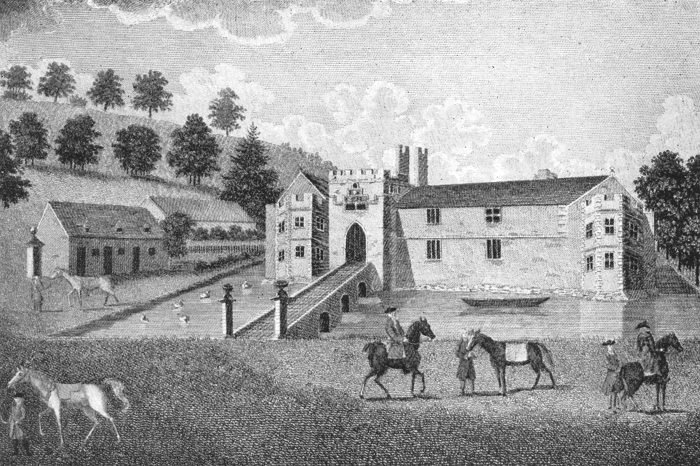
Himley moated manor
house, where Dud lived as a child. An
engineering drawing by Ravenhill, from
'Dudley' by G. Chandler and L. C. Hannah.
|
Dud took great interest in his
father's ironworks near Dudley, and obtained
considerable knowledge of the various processes
involved. He was a special favourite of his father, who
encouraged his interests in the improvement of iron
manufacture, and sent him to Balliol College Oxford, to
obtain an education that would help to turn his
excellent practical abilities to good use. He was there
until 1619 when his father sent for him to take charge
of an iron furnace and two forges at Pensnett.
After taking charge of the factory,
he discovered that wood for making charcoal was in short
supply, so he began to look into the possibility of
using coal, then known as pit coal, as a substitute. Dud
altered one of his furnaces to burn coal and carried out
a trial run. He was quite satisfied with the result and
decided to persevere, carrying out the same procedure as
before but with the addition of a second blast to
increase the active combustion of the fuel. He felt that
the small quantity of iron produced was of good enough
quality to be sold and so he wrote to his father, then
in London, to inform him of what he had done. He asked
him to obtain a patent for the invention from King
James, which was granted as patent No. 18, dated the
22nd February, 1620 and taken out in the name of
Lord Dudley himself.
Dud proceeded to produce iron in
this way, both at Pensnett and Cradley, where he built
another furnace. The following year he sent a quantity
of the new iron for testing, to the Tower of London,
following a command by the king. After the tests it was
pronounced to be good merchantable iron and so there was
every prospect that the new method of manufacture would
become established. He hoped that further improvements
could be made, but due to a succession of calamities,
manufacture came to an end.
The first calamity was a flood,
known as the "Great May day Flood" which destroyed his
main factory at Cradley and caused a lot of damage in
the area. Dud later recorded that part of Stourbridge
was deep in water: "At the market town called
Stourbridge," says Dud, "….although the author sent with
speed to preserve the people from drowning, and one
resolute man was carried from the bridge there in the
daytime, the nether part of the town was so deep in
water that the people had much ado to preserve their
lives in the uppermost rooms of their houses."
The next calamity came because the
hostile local iron smelters hoped that the flood had put
an end to Dud's pit coal iron making. They had seen
him making good iron by his new patent process, and
selling it at a cheaper price than they could manage.
They began to spread the word that his iron was bad and
not fit to be used. The iron smelters even appealed to
King James to put a stop to Dud's work, but Dud quickly repaired his
furnaces and forges after the flood, at great cost and
after a short time was making iron again. A fresh outcry
came from the local iron smelters who again appealed to
the king, who commanded Dud to send samples of all the
types of iron that he made to the Tower of London, as
quickly as possible for testing. The iron smelters were
unsuccessful in their efforts until 1624 when they
managed to limit Dud’s patent to 14 years instead of 31.
Dud carried on regardless and
accumulated a large stock of merchantable iron and sold
it for £12 per ton. He also made all kinds of cast iron
wares including brewing cisterns, pots and mortars. He
continued to have problems with the local iron smelters
who began to take out lawsuits against him and succeeded
in getting him ousted from his ironworks at Cradley. He
then set up a pit coal furnace at Himley, from where he
sold pig iron to charcoal ironmasters. He also built a
large furnace at Hasco Bridge (usually known as Askew
Bridge), on Himley Road. The furnace was built of stone,
27 feet square, with an unusually large bellows,
enabling 7 tons of iron to be produced per week. At the
time it would be the greatest quantity of pit coal iron
ever made in the country. Dud also opened a coal mine
above a 10 feet thick seam, lying over a large deposit
of ironstone.
When the factory had just been
completed, a mob of rioters, instigated by the charcoal
ironmasters, broke-in and destroyed everything, even
cutting the new bellows into pieces. Dud was attacked by
mobs, received countless lawsuits against him and was
eventually overwhelmed by debt. His creditors seized him
and took him to London, where he was held a prisoner in
one of the Compter prisons for debtors, for several
thousand pounds, until his patent expired.
|
|
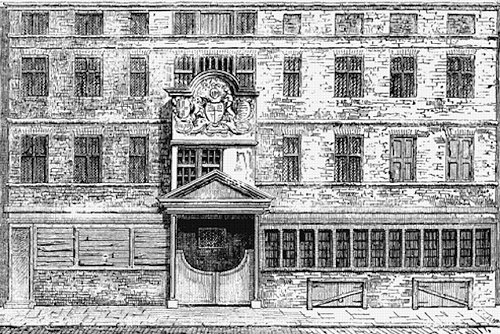
Wood Street Compter, London. |
The compters were terrible places, each run by a
sheriff and his staff, who charged the prisoners for
everything necessary for their survival and comfort,
including food, drink, clothes, bedding, heating and
medicine. Conditions were awful, many inmates died
from disease. |
|
Dud sought employment as an
adventurer with the court of Charles I and in 1637 was
sent by the crown on a mission to Scotland. The king seems to have taken pity on the
suffering inventor and granted him a renewal of his
patent in the year 1638. Dud obtained the patent with
three other partners; Sir George Horsey, David Ramsay,
and Roger Foulke. Soon after this happened, Dud became
involved in the army, supporting the king, and within a
few years the country was in turmoil when the Civil War
began.
Dud later claimed the manor of Himley, because his
father had at one point put it in his name, probably to
avoid it being seized by his creditors. This led to
Chancery proceedings, which he lost, and resulted in him spending time in
prison for contempt of court.
The Civil War
When the Civil War began in 1642,
Dud joined the Royalist side, supporting the king. As
previously mentioned, he had been employed by
the king in 1637 and was sent on a mission to Scotland.
In 1639 he accompanied the king on his expedition across
the Scottish border in the first Bishops’ War and was
present at the battle of Newburn in August 1640, when
the English army was defeated by the Scots.
Dud abandoned his ironworking and
became surveyor of the Mews or Armoury in 1640. In 1642
when the king left London to start his campaign, Dud
went with him and was present at Hull, when the king
went there to acquire arms that were stored in the weaponry
depository used in the previous Scottish campaigns. When
the king and his men arrived, Sir John Hotham, the
military governor appointed by Parliament, refused to
let them enter the town, and when Charles I arrived with
more men, they were driven off. Dud was also there when
the king raised his royal standard at Nottingham, and
also at Coventry, where the townspeople refused the king
entrance and fired on his troops from the city walls.
Dud also took part in the first
pitched battle of the war at Edgehill, on the 23rd
October 1642, which proved inconclusive, with both
Royalists and Parliamentarians claiming victory. After a
second field action at Turnham Green, the king withdrew
to Oxford, which became his base for the rest of the
war. Dud was in most of the battles that year, and also
acted as military engineer, supplying arms, shot and
cannon to the king’s forces at Stafford, Worcester,
Oxford and Dudley Castle.
Dud took part in the taking of
Lichfield and was made Colonel of Dragoons. He
accompanied the Queen with his regiment to the royal
headquarters at Oxford. In the autumn of 1643 he was at
the siege of Gloucester, followed by the first battle of
Newbury and later at Newport. In 1645 he was appointed
general of Prince Maurice's train of artillery, and
afterwards held the same rank under Lord Ashley. He was
taken prisoner at the end of the Siege of Worcester and
later released. When the first Civil War ended in 1646,
most of the Royalists who had fought in the First Civil
War gave their word not to bear arms against Parliament,
but when the war started again in 1648, the
Parliamentarians showed little mercy to those who had
brought war to the country again.
Nothing was heard of Dud until 1648
when he again joined the king’s forces. He proceeded to
raise 200 men, mostly at his own expense. They were no
sooner assembled in Bosco Bello (Boscobel) Woods near
Madeley, than they were attacked by the
Parliamentarians, and dispersed or taken prisoners. Dud
was taken prisoner and first marched to Hartlebury
Castle. Dud stated that 200 men were dispersed, killed,
and some taken, namely Major Harcourt, Major Elliotts,
Captain Long, and Cornet Hodgetts. Major Harcourt was
miserably burned with matches and the others were
stripped almost naked and marched to Worcester, where
they were kept close prisoners, with double guards both
at the prison and in the city.
Dud and Major Elliotts contrived to
break out of the prison and made their way over the tops
of the houses, passing the guards at the city gates, and
escaped into the open countryside. They were hotly
pursued and travelled during the night, hiding in trees
during the day. They succeeded in reaching London,
but were soon recaptured. Major Elliotts and Dud were
taken before Sir John Warner, the Lord Mayor. The
prisoners were sentenced to be shot to death, and
closely confined in the Gatehouse at Westminster, with
other Royalists.
On the day before their execution,
the prisoners formed a plan of escape. It was 10 o’clock
on the morning of Sunday the 20th August, 1648, in
'sermon time'. They overpowered the guards and Dud,
along with Sir Henry Bates, Major Elliotts, Captain
South, Captain Paris, and six others, managed to escape.
Dud received a wound in one leg and could only walk with
great difficulty. He proceeded on crutches, through
Worcester, Tewkesbury, and Gloucester to Bristol. On the
way he was fed for three weeks in 'an enemy's' hay mow
and was unrecognisable, as the helpless creature,
dragging himself along on crutches. He reached Bristol
safely and hid under the name of Dr. Hunt, a medical
doctor.
After the War
Dud lived in great secrecy until
after the execution of Charles I in January 1649 and the
end of the Royalist campaign in 1651. He then gradually
emerged from his concealment. His military career was
now over and he was penniless, reduced to a state of
utter destitution. His estate had been sequestrated by
the government, for treason, including Green Lodge and
his home in Worcester, where his sickly wife was turned
out of doors. His ironworks were also destroyed. Dud succeeded in finding two local
businessmen to join him as partners in an ironworks,
which they planned to build at Clifton. They were Walter
Stevens, a linen draper, and John Stone, a merchant.
Work was well under way on the new factory, when Dud
quarrelled with his partners and the scheme came to an
end.
Dud wrote the following about his
partners: 'They did unjustly enter Staple Actions in
Bristow because I was of the king's party; unto the
great prejudice of my inventions and proceedings, my
patent being then almost extinct, for which and my stock
am I forced to sue them in chancery.' He also wrote
that: 'Cromwell granted several patents and an act for
making iron with pit coal in the Forest of Dean, where
furnaces were erected at great cost.'
|
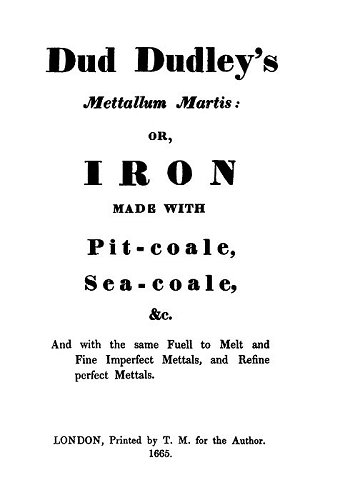 |
Dud was invited to visit the
furnaces and inspect the operations there by the owners,
who hoped that he would explain his secret process to
them. Try as they may, they could not discover how his
process worked and he stated that they would never
succeed in making iron profitably by the methods they
were using. The furnaces failed, as did the operations
at Bristol. Dud then asked Charles II, for a renewal of
his patent, but the king was besieged by many other
similar applicants, so Dud failed in obtaining the
renewal of his patent, whereas others were granted a
patent to make iron with coal.
Dud continued to petition the king,
asking to be restored as Sergeant at Arms, Lieutenant of
Ordnance, Surveyor of the Mews or Armoury, and also to
be appointed Master of the Charter House in Smithfield,
professing himself to be willing to do anything to make
a living.
After sending several petitions in 1660, he
was reappointed to the office of Sergeant at Arms and
his estate was returned to him. Some time later he was
again living at Green's Lodge, Swindon,
just south of Wombourne. Dud stated that nearby were
four forges: Green's Forge, Swin Forge, Heath Forge, and
Cradley Forge, all of which he operated.
|
|
In 1665, at
the request of his nephew Edward Parkhouse, Dud wrote
his treatise 'Metallum Martis', from where much of the
information about Dud comes.
It is possible that it was
written to impress the king and give more weight to his
petitions. Also to impress possible investors.
Dud then disappeared from sight.
He married his first wife, Eleanor Heaton, (1606 to
1675), on the 12th October, 1626 at St. Helen's Church,
Worcester.
Dud eventually retired to St. Helen's in
Worcester, where he died in 1684, in his 85th year. He
lived at 44 Friar Street, Worcester, where he had a
house that was previously owned by Eleanor Heaton’s
family. After her death, he married again and had a son
in his old age. |
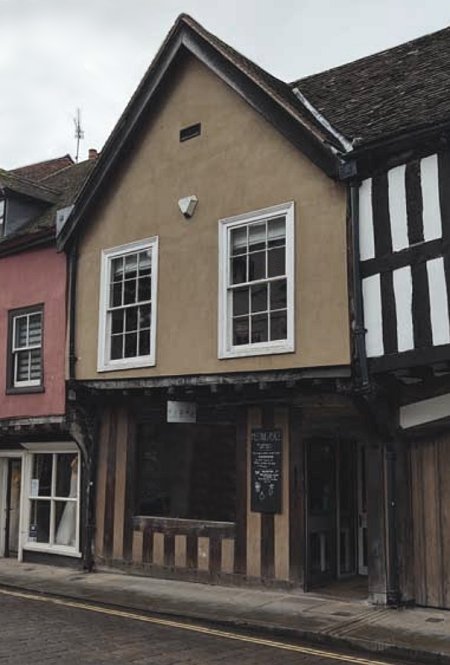
44 Friar Street, Worcester. Now
a café. |
|
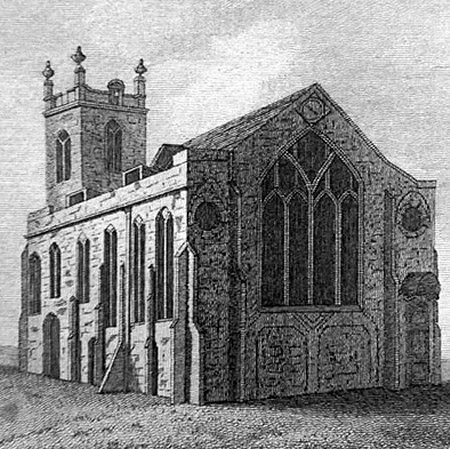
St. Helen's Church, Worcester. |
Dud was buried in St. Helen’s parish
church in Worcester, where he erected a monument to
himself, now destroyed. It carried the following
inscription:
Colonel Dud Dudley, son of the late noble Edward of
Dudley, dear to his father and most faithful subject and
servant to His Majesty the King, in vindicating the
church, in fighting for English law and liberty; often
captured, in the year 1648 once condemned nevertheless
not beheaded; born again, as an old man he sees an
unshakeable crown.
|
| Dud Dudley and Eleanor’s surviving monument is in the current
church
kitchen. The monument is
unusual as it contains chemical symbols written in Latin, including a list
of
metals: lead, tin, iron, gold, copper, silver and mercury. The monument was restored in 1911 by the Staffordshire
Iron and
Steel Institute. |
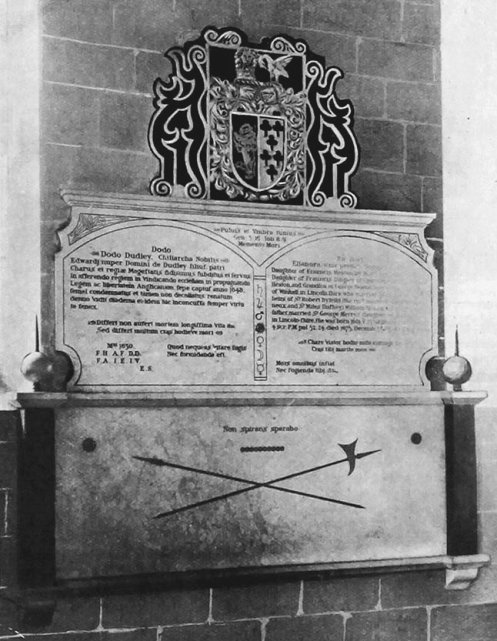
The existing monument to Dud and
his wife Eleanor, in St. Helen's Church. |
|
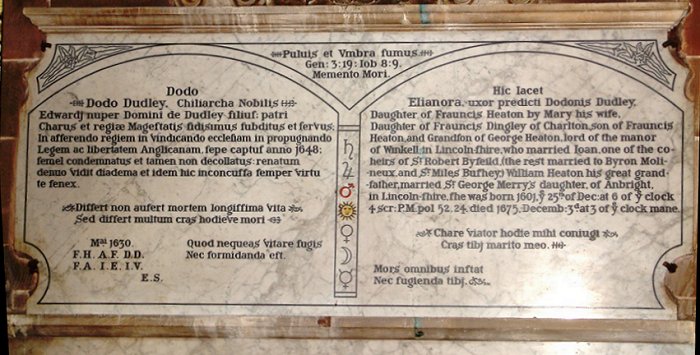
The inscription on the monument. |
|
Dud and his schemes had not been
liked by some members of the Sutton family. A relative
of his, John Bagley, accused him of wasting his father's
fortune on his coal mining schemes and bringing his
father to such destitution. His mother Elizabeth was
clearly aware of his nature and in her will she
requested that the money belonging to her, which was
passed-on to Dud, five years before her death, be given
instead to the poor people of Dudley. She also mentioned
in her will that Dud was not to see either her will or
her personal correspondence or diary. Dud did contest
his mother's will and claimed that he should own the
land where his industries stood, and also demanded the
ownership of Tipton Park and Parkfield, which Elizabeth
had owned.
Dud kept his iron smelting process a secret, not even
describing it in his 'Metallum
Martis'. He was never able to make more than five
tons a week on average, so his process never made a lot
of money. The high sulphur content in his iron meant
that it was not as good as that produced with charcoal.
He led an interesting and troubled life, and was lucky
to have survived the Civil War.
|
 |
Return to the
previous page |
|